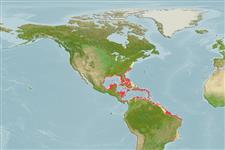Environment: milieu / climate zone / intervalo de profundidade / distribution range
Ecologia
marinhas associadas(os) a recifes; não migratória; intervalo de profundidade 2 - 60 m (Ref. 9626). Tropical; 22°C - 28°C; 44°N - 23°S, 98°W - 34°W
Western Atlantic: New England, USA to the vicinity of Rio de Janeiro, Brazil, including the Gulf of Mexico and the Caribbean (Ref. 26938).
Length at first maturity / Tamanho / Peso / Idade
Maturidade: Lm 22.6 range ? - ? cm
Max length : 60.0 cm TL macho/indeterminado; (Ref. 3797); common length : 45.0 cm TL macho/indeterminado; (Ref. 3797); peso máx. Publicado: 1.8 kg (Ref. 40637)
Espinhos dorsais (total) : 9; Raios dorsais moles (total) : 31 - 33; Espinhos anais: 3; Raios anais moles: 23 - 25. Pale gray around mouth, and pale gray margin on caudal fin. Inside of pectoral fin yellow (Ref. 26938). Juveniles are black with two light yellow bars on body and three on head; caudal fin yellow with a vertically elongate, nearly rectangular or hemispherical black spot in middle (Ref. 13442).
Body shape (shape guide): short and / or deep; Cross section: compressed.
Maximum depth from Ref. 126840. Common in coral reefs, usually solitary, occasionally in pairs. Juveniles are part-time cleaners. Feed mainly on sponges, but also takes tunicates, algae, zoantharians, gorgonians, hydroids, bryozoans, and seagrasses. Oviparous (Ref. 240), monogamous (Ref. 52884). Flesh reported to be of excellent quality (Ref. 3797); marketed fresh and salted (Ref. 5217). Friendly toward divers (Ref. 9710). Have been reared in captivity (Ref. 35419).
Life cycle and mating behavior
Maturidade | Reprodução | Desova | Ovos | Fecundidade | Larvas
Monogamous mating is observed as both facultative and social (Ref. 52884).
Allen, G.R., 1985. Butterfly and angelfishes of the world. Vol. 2. 3rd edit. in English. Mergus Publishers, Melle, Germany. (Ref. 4858)
Categoria na Lista Vermelha da IUCN (Ref. 130435: Version 2025-1)
Ameaça para o homem
Reports of ciguatera poisoning (Ref. 30303)
Utilização humana
Pescarias: pouco comercial; Aquário: Espécies comerciais
Ferramentas
Relatórios especiais
Descarregue XML
Fontes da internet
Estimates based on models
Preferred temperature (Ref.
123201): 23.8 - 28.1, mean 27.3 °C (based on 849 cells).
Phylogenetic diversity index (Ref.
82804): PD
50 = 0.5001 [Uniqueness, from 0.5 = low to 2.0 = high].
Bayesian length-weight: a=0.03162 (0.01593 - 0.06279), b=2.90 (2.73 - 3.07), in cm total length, based on LWR estimates for this species & Genus-body shape (Ref.
93245).
Nível Trófico (Ref.
69278): 3.2 ±0.1 se; based on diet studies.
Resiliência (Ref.
120179): Muito baixo, tempo mínimo de duplicação da população maior que 14 anos (Preliminary K or Fecundity.).
Fishing Vulnerability (Ref.
59153): Moderate vulnerability (44 of 100).
🛈
Nutrients (Ref.
124155): Calcium = 31.5 [15.9, 53.1] mg/100g; Iron = 0.459 [0.273, 0.748] mg/100g; Protein = 18.5 [17.3, 19.7] %; Omega3 = 0.085 [0.053, 0.137] g/100g; Selenium = 34.4 [17.3, 66.9] μg/100g; VitaminA = 54.3 [13.7, 197.7] μg/100g; Zinc = 1.1 [0.8, 1.6] mg/100g (wet weight);
